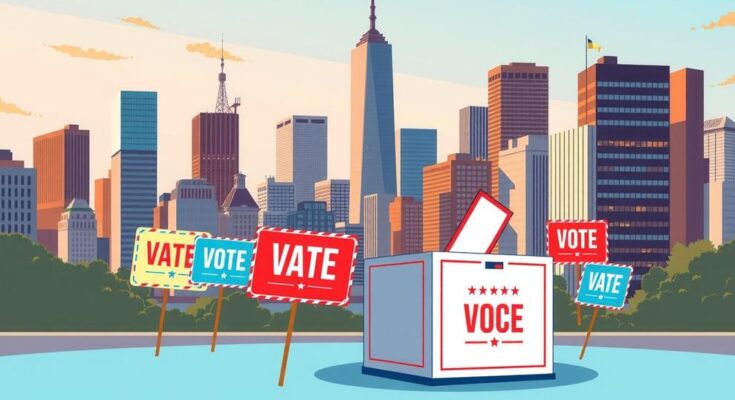New Yorkers are on the edge of their seats as the mayoral primary approaches, where tension sizzles and candidates vie against a backdrop of heat and uncertainty. Who will emerge victorious?
Stage Set for a Competitive Mayoral Primary
As New Yorkers prepared for their mayoral primary, the day was charged with the kind of energy that’s often reserved for grand events. With 11 candidates and two frontrunners, the stage was set for a showdown between the established Andrew Cuomo and the rising star Zohran Mamdani. The atmosphere was electric, not just from the anticipation but also from the sweltering heat gripping the city. Some voters were restless, recalling the past few weeks of campaigning that seemed to intensify with each passing day, all leading up to this very moment.
Cuomo and Mamdani: A Tale of Two Candidates
Cuomo, taking a break from the limelight, made a subtle entrance at a local high school to cast his vote. His strategy? To focus on himself, eschewing any ranking of the other candidates. Meanwhile, somewhere in the city, Mamdani was out and about – energising the crowd, surrounded by enthusiastic volunteers and supporters. The big narrative had become crystal clear in the days leading up to the primary: while Mamdani represented a younger, more progressive politics, Cuomo sought to embody experience and stability—a polarising contrast that had many voters on either side weighing their options with uncertainty.
Rivalries and Troubles: Candidates Under Fire
In the run-up to the primary, nervous whispers filled the air, particularly in Cuomo’s camp. Once seen as the frontrunner, Cuomo’s support appeared to be teetering. On the flip side, Mamdani’s supporters were riding a wave of optimism that he could seize this moment. Distrust clouded Cuomo’s past, with allegations of sexual harassment lingering and his handling of the pandemic continuing to raise eyebrows. Mamdani’s critics were not quiet either, calling out his inexperience and controversial statements. The confluences of these contrasting views made for a politically charged environment lasting well through election day.
Cuomo’s Campaign: Experience vs. Controversy
Cuomo, leveraging his established political connections—like that of Bill Clinton’s recent endorsement—championed his campaign as a stabilising force against the perceived leftward shift of the Democratic Party. During a recent rally, he slammed progressive policies, labelling them utopian fantasies detached from reality, arguing that they had contributed to the city’s downward spiral. Critics, however, decried that his past decisions damaged New Yorkers’ trust and safety, and voters expressed their hesitance to back him based on those memories.
Mamdani’s Vision: Promising Change or Dismissed Ideals?
In contrast, Mamdani’s approach celebrated a new wave of leadership that resonated particularly with younger voters. His vision for the city included bold ideas—rent freezes, grocery stores owned by the city, and a fresh, uncompromising outlook on political change. For him, the lack of seasoned baggage held a certain charm, suggesting a clean-slate policy agenda that he claimed could reinvigorate the Big Apple by offering real solutions to pressing problems. But as excitement brewed, Mamdani also faced slings of criticism for his socialist ideals, including accusations of antisemitism, a sticky web he aimed to navigate carefully in public discussions.
A Complicated Vote: The Waiting Game
The month’s heat was not merely weather-related; it extended to the complexities of the ranked-choice voting system lurking in the background of the primary. As New Yorkers waited for results, the anticipation was palpable—would the city’s voting procedures lead to another drawn-out tally? In 2021, results were in limbo for days. Candidates were determined to play into voters’ preferences, with strategic alliances and cross-endorsements creating a labyrinthine ballot process that had many scratching their heads. Would voters successfully navigate these twists? Or would confusion reign?
Heatwave Challenges Emerge for Voter Turnout
Adding another layer to this competitive scene, the sweltering heat that day challenged voter turnout, particularly among elderly citizens—potentially hindering Cuomo and Mamdani alike. Yet it was uncertain if it would favour one candidate over another. To combat this, the New York City Board of Elections launched an operation to distribute fans and ice water to cooling stations, desperately trying to ensure a smooth voting process. Voter turnout could literally boil down to these logistical decisions, further complicating an already messy political climate. Legal challenges were also anticipated if any hiccups occurred at polling stations.
Primary Outcomes: No Certainties in a Heavy Contest
Finally, even if a candidate secures the Democratic nomination, there’s no guarantee of winning against the Republican frontrunners lurking on the sidelines. Historical data suggests the unpredictable nature of New York’s mayoral elections, with past Republican wins casting shadows over the projected landscape. Cuomo was toying with a plan to maintain his presence on ballots, regardless of the primary result, as Mamdani’s path might pivot through the Working Families Party’s ballot line if needed. With the incumbent mayor, Eric Adams, holding a notable edge and the support of past political allies, the mayoral race appears more tangled than anyone might have anticipated.
A Night of Decisions: What Lies Ahead
As the primary night unfolded, it wasn’t merely about votes; it was about the fabric of New York City politics, stitched together with sweat, hopes, and unresolved issues. The stakes were higher than ever, shaped by past legacies and the pulse of new aspirations. Ultimately, who will emerge as the people’s choice, and what this means for the future of city governance is still anyone’s guess, but certainly, the whispers of change are in the air.
As New Yorkers head into uncertain times, the outcome tonight is set to reflect the city’s current political landscape. With tensions high between the two frontrunners, the decision will likely hinge on which candidate voters find more acceptable—or entirely unacceptable. The complex layers of this primary could very well reshape the city’s leadership going forward, with lingering questions of trust, change, and how deeply New Yorkers are willing to embrace that change to ensure a brighter future beneath the city’s shimmering skyline.




